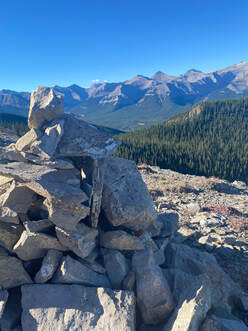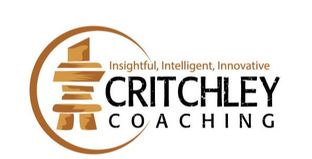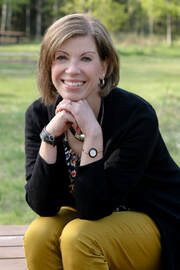
We were hiking a trail I had not done before but that we’d talked about doing since early in the season. It’s a good late-in-the-season hike because of its difficulty. It takes until this time of the hiking season for our legs to be ready for the climbing.
Brenda had done this one years prior and we’d both admired Forgetmenot Mountain throughout the season as we’d hiked trails nearby.
As we started up the fairly steep ascent, we checked in with each other to make sure we were each still a ‘GO’. We agreed the sescent would be hard but we’d be fine if we went slowly. Once we got above the tree line and began crossing the scree slope (an expanse of broken, loose rocks) it was hard to find the trail. The great news was there was a wide area to navigate within and we could see the general direction of the next climb where we were headed.
The other wonderful thing was that hikers who had come months and years before us had erected cairns to mark the way. These guideposts, piles of rock really, can be found on almost every mountain hike. They mark spots where a change in direction might be required, or where a potentially hard to spot trail might be hiding, or, in our case, they were there just to keep us headed in the right direction across the wide ridge.
I’ve learned to watch for and be thankful for these cairns. Hikers protocol asks us to add a rock to each pile as we pass by. This is both a practical and symbolic gesture. It helps those coming from behind and it reminds us all that we are in this walk of life together.
As we hiked along on Tuesday, I had plenty of time to think about guideposts. We benefitted from several that day.
At the far end of the ridge was another tall outcropping of rock which would become our second ascent. There is a ‘path’ pointing to the top, but once the sparce grass of a meadow ended, the path disappeared in the rock. Two other hikers happened along as we were pondering our next move. They had both been there before, were clearly very experienced hikers and they offered that we could follow them up. They also knew of the gentler way down. Brenda had heard about this way, and in fact had travelled it before but could not recall where to find its beginning. We’d been hoping it would be obvious once we were at the top.
Brenda and I weighed our options and decided to follow Marek and Peter. They were excellent guides, steering us safely up the side of the rocks. Traverse to the left, Marek would call down. You’ll get better footing there.
At the top we all stopped and enjoyed our lunches. We sat protected from the fierce wind by a ten (ish) foot wall of rock. No matter how comfortable we were, we couldn’t help but wonder where exactly the easier way down was. It turned out it wasn’t far away at all; just about 100 metres on the other side of the outcrop. The challenge? We had to make our way around the cliffside to get to it.
To understate, neither of us is fond of heights. I would also admit to being low on the ‘careless’ scale. We decided to give it a look. It took very few steps, for us to realize we had to rethink our plan. The rocky non-path led us along jagged rocks, with a wall of stone on our left, and a several hundred foot drop on our right.
The guideposts leading us to our moment of decision had been great. The cairns steered us in the right direction, and the two hikers, Marek and Peter, had led us to the possible easier descent. Yet as we realized we simply were not willing to risk walking around the side of the cliff, we had to look for guideposts elsewhere. We found them exactly where we knew they would be. Inside ourselves.
It's perfect when your partner and you agree on how difficult decisions should be made. Brenda and I are a great team in this regard. We asked each other only one question.
“What is the safest choice we can make?”
The answer was easy. We needed to go down the way we came up. Despite the fact this way would not be easy, and would involve first finding a possible way off the outcrop, then crab walking backward until we were off it, then navigating the steep but obvious path down, this was the way we knew for sure. This would be where someone would look for us if for any reason we ran into trouble. With the decision easily made, we headed down.
We’ve all benefitted from the experience of having guideposts, not just those on the trail, but those in our lives. Sometimes they come in the form of people. Sometimes we read just the right words at just the right time. Sometimes we see something we are sure is a sign sent from someone we love. Sometimes we literally reach a roadblock and have to change direction. These are all helpful and comforting ‘cairns’ to notice.
But the most important guidepost of all is one we always carry. It is that of our inner voice. Not the one that whispers tales of dread and potential disaster in our ears, but the one that reminds of us our values. When we can clear out the noise and quietly get in tune with which guideposts we want to use to lead us through life, our decision making is suddenly very, very easy. The steps we have to take may still be difficult, as they were for Brenda and I on Tuesday, but making the right decision was easy. Almost always when we are clear about our values, and use them as our cairns, we find a feeling of peace within ourselves. This too, is a sign we are on the right path.
Since Tuesday I’ve been mindful of trying to create the feeling of peace, that comes with living in full alignment with my values. I still want to climb mountains and have adventures and live a rich and rewarding life. The best way I know how to do this is to notice cairns on my path, add stones to the those I find on the way, thank living guides for their assistance, and to follow my own values.
My inquiry for you this week is, ‘What guidepost best serves me now?’
Elizabeth is a certified professional Leadership Coach, and the owner of Critchley Coaching. She is the founder and president of the Canadian charity, RDL Building Hope Society. She works with corporations, non-profits and the public sector, providing leadership coaching. She creates and facilitates custom workshops for all sizes of groups. She has particular expertise in facilitating Strategic Plans for organizations. Contact Elizabeth to learn to recognize guideposts.


 RSS Feed
RSS Feed